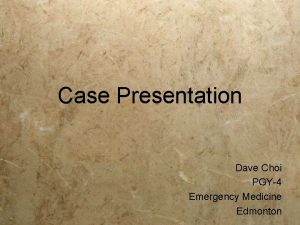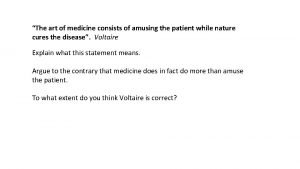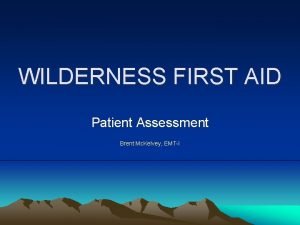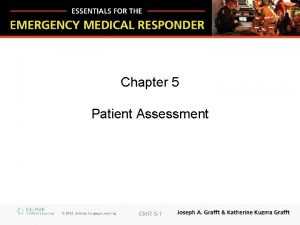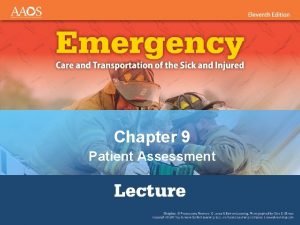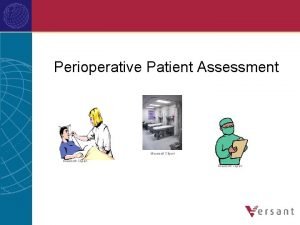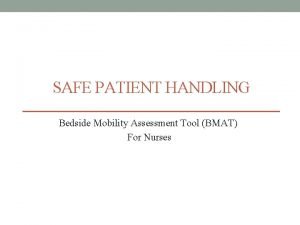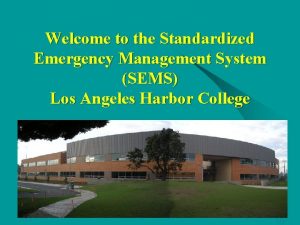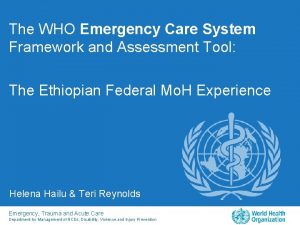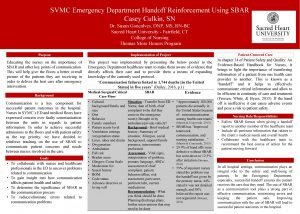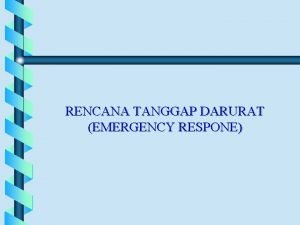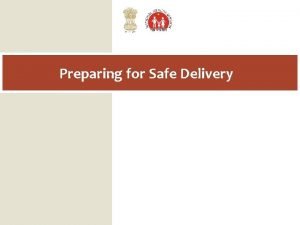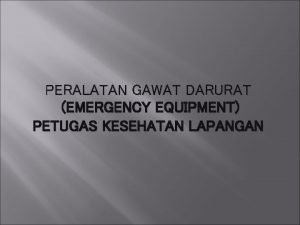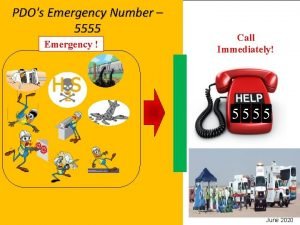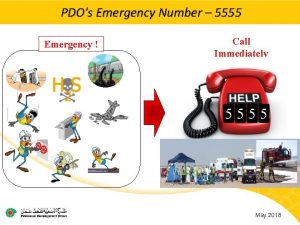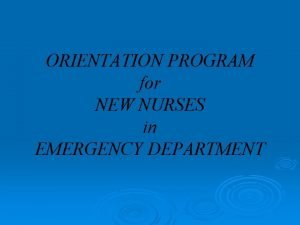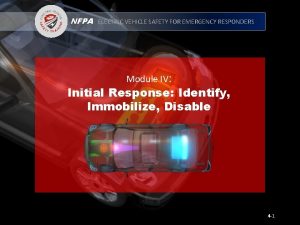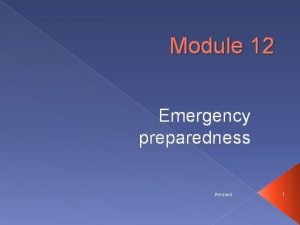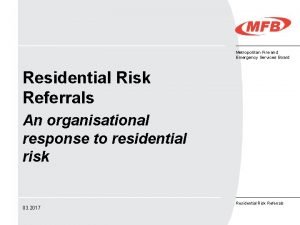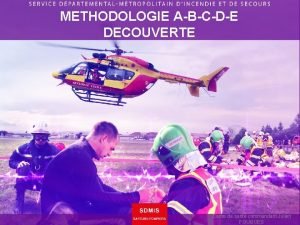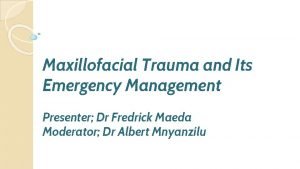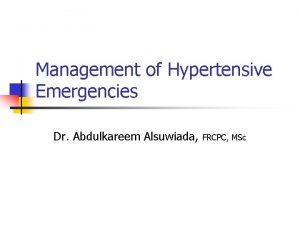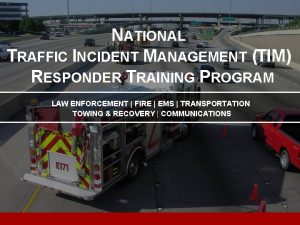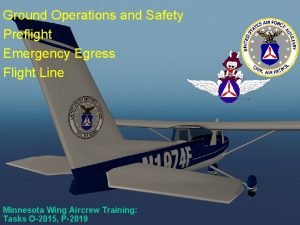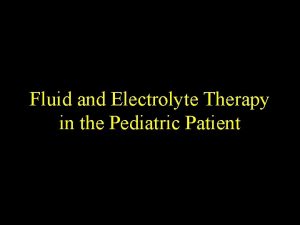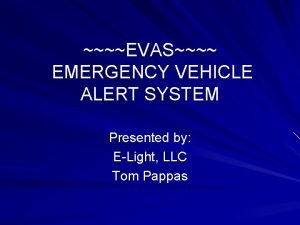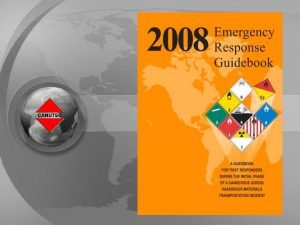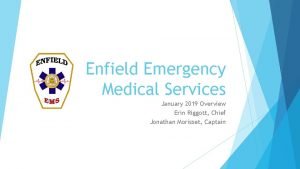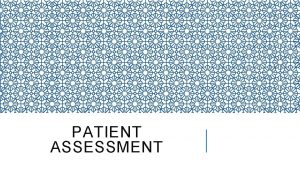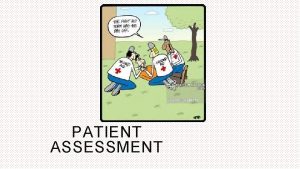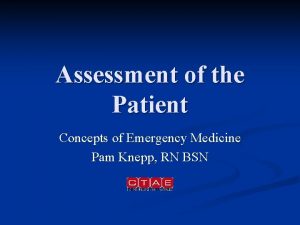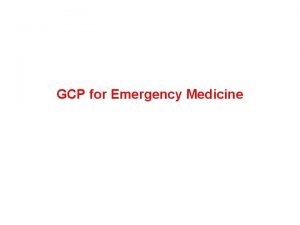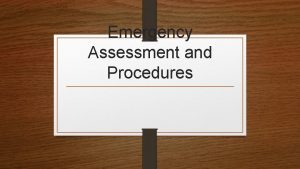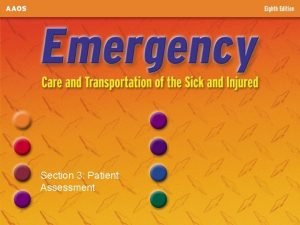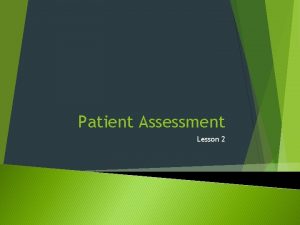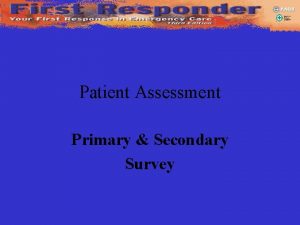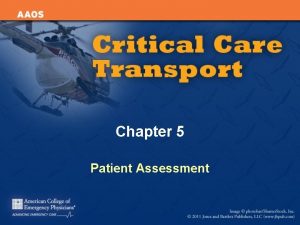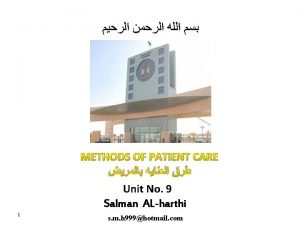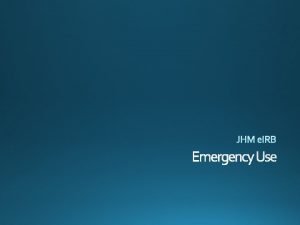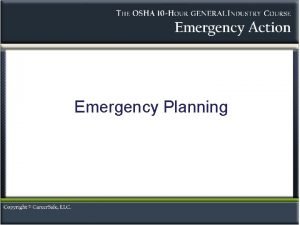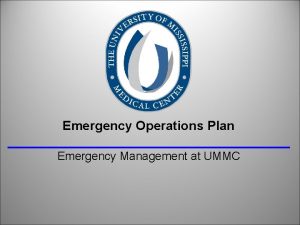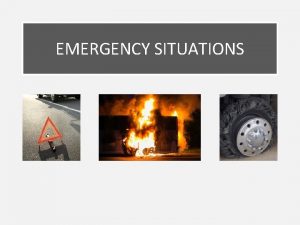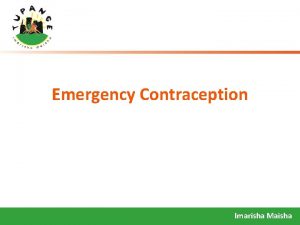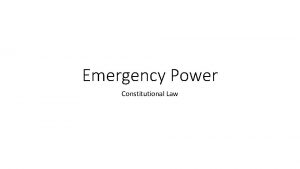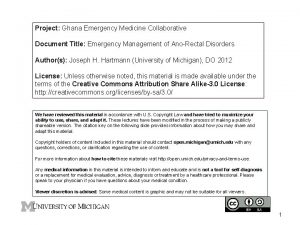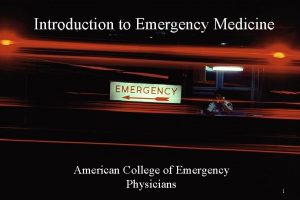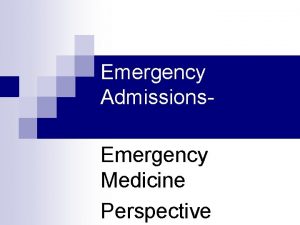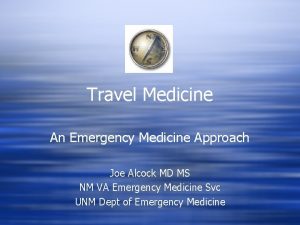Assessment of the Patient Concepts of Emergency Medicine























































































- Slides: 87

Assessment of the Patient Concepts of Emergency Medicine M. Rich, RN, BSN

Bell Work: 2 -15 -18 1. 2. 3. What are three contraindications for putting a blood pressure cuff on a patient’s arm? What is the difference between systolic and diastolic pressure called? How would you evaluate capillary refill?

Standard 18) Accurately perform the components of patient assessment to identify and manage immediate life threatening illnesses and injuries within the scope of practice of the EMR for pediatric, adult, and geriatric patients, utilizing rubrics from textbooks, National HOSA guidelines, or clinical standards of practice. Include the following areas: a. Scene Size-up b. Primary Survey or Assessment c. History Taking d. Secondary Assessment e. Vital Signs f. Reassessment

Objectives Understand how an EMR would coordinate n Scene Size-up n Initial Assessment n Focused History and Physical Exam n Vital Signs n Secondary or Ongoing Assessment n Hand-off to EMTs

Patient Assessment Bergeron, J. David & Chris Le Bandour. (2009). First Responder. 8 th Edition. Pearson Prentice Hall. Upper Saddle

Scene Size-up n Every patient assessment begins with scene size -up, which includes: n n n Taking BSI precautions (body substance isolation) Determining if the scene is safe Identifying the MOI (mechanism of injury) or nature of illness Determining the number of patients Identifying any additional resources needed

Scene Size-up n BSI precautions Rescuer wears protective eye wear.

Scene Size-up n BSI precautions Rescuer dons gloves.

Scene Size-up n BSI precautions Rescuer wears both a gown and a simple surgical mask.

Scene Size-up n BSI precautions Rescuer wears a HEPA mask. (filters the air so less allergens or pollutants are being inhaled)

Scene Size-up *Scene Safety: An assessment of the scene and surroundings will provide valuable information to the First Responder and will ensure the well-being of the First Responder.

Scene Size-up n Scene Safety: 1) Personal protection Protection of the patient Protection of bystanders 2) 3) **If the scene is not safe, make it safe. Otherwise, DO NOT ENTER.

Scene Size-up n Unstable situation n Haz. MAT situation n Violent situation

Scene Size-up *Identify Mechanism of Injury: n In trauma situations n An evaluation of the forces that caused an injury n May be beneficial in determining the presence of internal injuries n Determined from the patient, family, or bystanders, and inspection of the scene

Scene Size-up *Identify Mechanism of injury Trauma patient

Scene Size-up *Identify mechanism of injury Impact #1 “A car collides head on with a tree. ”

Scene Size-up *Identify Mechanism of injury Impact #2 “The car collision causes the drivers chest to hit steering wheel. ” “The steering wheel causes damage to the chest area and broken ribs. ”

Scene Size-up *Identify mechanism of injury “The impact of the steering wheel to the drives chest area cause additional damage to inner organs. ” Impact #3

Scene Size-up *Identify nature of illness: n In medical situations n Determined from the patient, family, or bystanders n Why was EMS called?

Scene Size-up *Identify nature of illness

Scene Size-up n Determine the number of patients and additional resources needed: n It is important to account for all patients involved. n Request additional resources if needed: n Fire department n Police n ALS crews (Advanced Life Support) n Rescue n Utilities n Call for resources early.

Scene Size Up n https: //www. youtube. com/watch? v=3 q 3 i. M at. Cnes

Objectives Understand how an EMR would coordinate n Scene Size-up n Initial Assessment n Focused History and Physical Exam n Vital Signs n Secondary or Ongoing Assessment n Hand-off to EMTs

Initial Assessment n Form a general impression of the patient. n Assess the patient’s mental status. n Assess the patient’s airway. n Assess the patient’s breathing. n Assess the patient’s circulation. n Make a decision on the priority the patient (notify dispatch)

Initial Assessment The initial assessment is completed to assist the First Responder in identifying Immediate Threats to Life.

Initial Assessment n Form a General Impression of the Patient Based on the First Responder’s immediate assessment of the environment and the patient’s chief complaint.

Initial Assessment n Form a general impression of the patient n Assess the Patient’s Mental Status: n Classify the patient’s mental status into one of the following categories: n Alert n Verbal n Painful n Unresponsive

Initial Assessment *Assess the patient’s airway Head-Tilt; Chin-Lift

Initial Assessment *Assess the patient’s airway Jaw-thrust maneuver (with suspected neck injury) https: //www. youtube. com/watch? v=XNZed 1 o. Be. TA

Initial Assessment *Assess the patient’s airway Suction of needed

Initial Assessment *Assess the patient’s airway Insert an airway adjunct as needed https: //www. youtube. com/watch? v=v gq. Orm. Bskaw

Initial Assessment *Assess the patient’s breathing n Look at the effort of breathing. n Look, listen, and feel for presence of ventilations. n Ventilate as needed.

Airway assessment n https: //www. ems 1. com/emsproducts/medical-equipment/airwaymanagement/video/2179098 -Remember-2 -Things-Anaphylaxis-and-upper-airwayassessment/

Initial Assessment n Assess the patient’s circulation n Check for a pulse (carotid artery in adults and brachial artery in infants). n Check for serious bleeding (control bleeding). n Check skin color.

Initial Assessment Make a decision on the priority of the patient and alert dispatch. High priority: n n Poor general impression n Unresponsiveness n Breathing difficulties n Severe bleeding or shock n Complicated childbirth n Chest pain n Severe pain

Work it out Finish up: BP of classmates Page 295, questions 3 -5 and 7 -12 Page 394, questions 2 -5, 7 -12

Bell Work: 2 -20 -2018 1. What would a narrow pulse pressure indicate? 2. What would a widened pulse pressure indicate? 3. What is the first thing you would do after getting called to a scene? 4. In scene size up, what is your MOI? 5. What do you do first in your initial assessment?

Standard 18) Accurately perform the components of patient assessment to identify and manage immediate life threatening illnesses and injuries within the scope of practice of the EMR for pediatric, adult, and geriatric patients, utilizing rubrics from textbooks, National HOSA guidelines, or clinical standards of practice. Include the following areas: a. Scene Size-up b. Primary Survey or Assessment c. History Taking d. Secondary Assessment e. Vital Signs f. Reassessment

Standard n 14) Interpret the rules, guidelines, and legal ramifications related to incident documentation by EMS staff. Complete a pre-hospital care report utilizing appropriate medical terminology and the acronyms SAMPLE, DCAP-BTLS, and OPQRST

Objectives Understand how an EMR would coordinate n Scene Size-up n Initial Assessment n Focused History and Physical Exam n Vital Signs n Secondary or Ongoing Assessment n Hand-off to EMTs

Focused History and Physical Exam Trauma Patient Medical Patient Significant Mechanism of Injury Unresponsive Medical Patient • Perform a rapid trauma assessment (DCAP-BTLS) • Take vital signs • Gather SAMPLE history • Perform a rapid physical assessment (DCAP-BTLS) • Take vital signs • Gather SAMPLE history No Significant Mechanism of Injury Responsive Medical Patient • Perform a focused trauma assessment • Gather SAMPLE history • Perform focused physical exam • Take vital signs • Gather SAMBLE history

Focused History and Physical Exam n Trauma Patient—Significant MOI: n Significant mechanisms of injury include: n n n n n Ejection from a vehicle Death of another passengers in a MVC Falls greater than 15 feet Rollover vehicle collision High-speed vehicle collision Vehicle-pedestrian collision Motorcycle crash Unresponsiveness or altered mental status Penetrations of the head, chest, or abdomen

Focused History and Physical Exam * Trauma Patient—Significant MOI: n Significant mechanisms of injury in a child include: n Falls greater than 10 feet n Bicycle collision n Medium-speed vehicle collision

Focused History and Physical Exam DCAP-BTLS: • • Deformities Contusions Abrasions Punctures and Penetrations Burns Tenderness Lacerations Swelling

DCAP n Deformities: Is there an abnormality in the shape of a body part or organ compared to the normal shape? n Contusions: Do you notice bruising? In extreme cases, this can cause blood to seep, hemorrhage or extravasate into surrounding tissues. n Abrasions: How severe is the abrasion? Your treatment will vary depending on the severity, but be sure to always clean and remove any debris. n Punctures/penetrations: Penetrating trauma suggests an object didn't pass through, while perforating trauma is associated with an entrance and exit wound.

BTLS n n Burns: Treatment depends on the severity of the burn. Tenderness: This shouldn't be confused with pain. Tenderness is triggered by discomfort when an affected area is touched. Lacerations: Treatment depends on the type, cause and depth of the wound. Minor wounds heal on their own, while puncture wounds are more prone to infection. Swelling: This is an abnormal enlargement of a body part or area. Swelling may occur in response to infection, injury or disease.

Focused History and Physical Exam n Trauma patient – Rapid trauma assessment Stabilize the head and neck, and check the head (scalp and face).

Focused History and Physical Exam * Trauma assessment – rapid trauma assessment Check the neck and apply a cervical collar (if trained to do so). Note any swelling or tenderness.

Focused history and physical exam Trauma patient – rapid trauma assessment n Check the chest n Check each quadrant of the abdomen (note any abnormalities, tenderness, or foreign bodies) n

Focused History and Physical exam n Trauma Patient— Rapid Trauma Assessment Check the pelvis, pressing gently down and inward.

Focused History and Physical Exam * Trauma Patient— Rapid Trauma Assessment Check the extremities, legs, and then arms (look for any deformity, swelling, or discoloration).

Focused History and Physical Exam * Trauma Patient— Rapid Trauma Assessment Check for distal pulse, motor function, and sensation in each extremity.

Focused History and Physical Exam * Trauma Patient—Rapid Trauma Assessment Check the back and buttocks while maintaining c-spine immobilization: 1) keep arms close to center of body and patient is moved keeping the entire body aligned while rolling patient on his side. 2) the patient is rolled on the count of the person holding c-spine.


Videos https: //www. youtube. com/watch? v=t. Kv 2 Bs 83 r. I https: //www. youtube. com/watch? v=mwcau. T 5 jm. HI

Focused History and Physical Exam * Trauma Patient—No Significant MOI: n Steps of assessment include: n Perform a focused trauma assessment. n Take vital signs. n Gather SAMPLE history. S-signs/symptoms A-allergies M-medication P-past history L-last oral intake E-events prior

Focused History and Physical Exam * Trauma Patient—Focused Trauma Assessment 1) 2) 3) Examine the area that is injured. Take vital signs. Provide appropriate care (i. e. stabilize any injuries, control bleeding, dress wounds)

Focused History and Physical Exam n Trauma Patient: n SAMPLE History: n Signs and symptoms n Allergies n Medications n Pertinent past medical history n Last oral intake n Events leading to the illness or injury

Focused History and Physical Exam * Medical Patient—Unresponsive: n Steps of assessment include: n Perform a rapid physical exam (head-to-toe). n Take vital signs (pulse, respirations, blood pressure – if equipment available, mental status). n Gather SAMPLE history.

Focused History and Physical Exam * Medical Patient—Responsive: n Steps of assessment include: n Gather SAMPLE history. n Take vital signs (pulse, respirations, blood pressure-if equipment available, mental status) n Perform n a focused physical exam. Area of chief complaint **Note any medical identification devices (i. e. allergy bracelets)

OPQRST n OPQRST is a useful mnemonic (memory device) for learning about your patient’s pain complaint.

OPQRST n n n Onset: “Did your pain start suddenly or gradually get worse and worse? ” This is also a chance to ask, “What were you doing when the pain started? ” Provokes or Palliates: Instead of asking, “What provokes your pain? ” use real, casual words. Try, “What makes your pain better or worse? ” Quality: Asking, “Is your pain sharp or dull? ” limits your patient to two choices, when their pain might not be either. Instead ask, “What words would you use to describe your pain? ” or “What

OPQRST n n n Radiates: This is another chance to use real, conversational words during assessment. Asking, “Does your pain radiate? ” sounds silly and pompous to the patient. Instead use this question, “Point to where it hurts the most. Where does your pain go from there? ” Severity: Remember, pain is subjective and relative to each individual patient you treat. Have an open mind for any response from 0 to 10. Time: This is a reference to when the pain started or how long ago it started.

Work it out n Page 407, questions 1 -10

Bell Work 2 -21 -2018 1. 2. 3. What is DCAP-BTLS? When do you use it? What is a SAMPLE History. How do you get it if the patient is unresponsive? What is OPQRST?

Objectives Understand how an EMR would coordinate n Scene Size-up n Initial Assessment n Focused History and Physical Exam n Vital Signs n Secondary or Ongoing Assessment n Hand-off to EMTs

Vital Signs * Pulse: Assess for three characteristics: n Rate (number of beats per minute) n Strength (weak, bounding, thready, absent) n Rhythm (regular or irregular) n Carotid pulse in the neck (most distinct pulse felt) n Radial pulse in the lateral portion of the forearm, on the thumb side of the wrist (most easily accessible) n

Vital Signs * Pulse: n To measure a radial pulse rate (number of beats/minute) n Use your 1 st and 2 nd fingertips to feel for an artery. n Do not use your thumb. n Find the artery (usually radial or carotid) n Apply moderate pressure. n Count the beats for 30 seconds. n Multiply your 30 -second count by 2.

Vital Signs * Pulse: The normal pulse rate for adults is 60– 100 bpm. n Rate > 100 = Tachycardia n Rate < 60 = Bradycardia n Newborn infants = 120 to 160 bpm n Up to 5 years old = 80 to 140 bpm n 5 to 12 years of age = 70 to 110 bpm n

Vital Signs *PULSE Observation Possible Problem Rapid, strong pulse Internal bleeding (early stages), fear, heat emergency, overexertion, high blood pressure, fever Rapid, weak pulse Shock, blood loss, heat emergency, diabetic emergency, failing circulatory system Slow, strong pulse Stroke, skull fracture, brain injury No pulse Cardiac arrest Bergeron et al. (2009) First Responder. 8 th Edition. Pearson Prentice Hall. Upper Saddle River: NJ.

Vital Signs * Respirations: n Assess for 2 characteristics: n Rate: n Slow n Normal n Rapid n Character: n Rhythm—(Regular or Irregular) n Depth—(Normal, Shallow, or Deep) n Sound—(Abnormal Sounds) n Ease—(Labored, Difficult, or Painful)

Vital Signs n Respirations: n To measure & assess respirations: n After pulse count, leave your hand on the wrist. n Observe the rise and fall of the chest. n Listen for sounds. n Count the number of breaths in 30 seconds. n Multiply your 30 -second count by 2. n Note rhythm, depth, sound, and ease of breathing.

Vital Signs Observation Possible Problem Rapid, shallow breaths Shock, heart problems, heat emergency, diabetic emergency, heart failure, pneumonia Deep, gasping labored breaths Airway obstruction, heart failure, heart attack, lung disease, chest injury, diabetic emergency Slow breathing Head injury, stroke, chest injury, certain drugs Snoring Stroke, fractured skull, drug or alcohol abuse, partial airway obstruction Crowing Airway obstruction, airway injury due to heat Gurgling Airway obstruction, lung disease, lung injury due to heat Wheezing Asthma, emphysema, airway obstruction, heart failure Coughing blood Chest wound, chest infection, fractured ribs, punctured lung, internal injury Bergeron et al. (2009). First Responder. 8 th Edition. Pearson Prentice Hall. Upper Saddle River: NJ.

Vital Signs * Respirations: The normal respiratory rate for adults is 12– 24 breaths per minute. n > 28 or < 8 are considered serious. n Newborn infants = 25– 50 breaths per min. n Up to 5 years old = 20– 30 breaths per min. n 5 to 12 years of age = 15– 30 breaths per min. n

Vital Signs *Skin color, temperature, moisture Observation Significant / Possible Problem Pink Normal in light-skinned patients; normal in inner eyelids, lips, and nail beds of dark-skinned patients Pale Constricted blood vessels possibly resulting from blood loss, shock, decreased blood pressure, emotional distress Blue (cyanotic) Lack of oxygen in blood cells and tissue resulting from inadequate breathing or heart function Red (flushed) Heat exposure, high blood pressure, emotional excitement; cherry red indicates late stages of carbon monoxide poisoning Yellow (jaundiced) Liver abnormalities Blotchiness (mottling) Occasionally in patients that are in shock Bergeron et al. (2009). First Responder. 8 th Edition. Pearson Prentice Hall. Upper Saddle Hall: NJ.

Vital Signs *Skin signs Skin Signs Significant / Possible Problem Cool, clammy Shock, anxiety, heart attack Cold, moist Body is losing heat Cold, dry Exposure to cold Hot, dry High fever, heat emergency, spinal injury Hot, moist High fever, heat emergency Goose bumps accompanied by shivering, chattering teeth, blue lips, and pale skin Chills, communicable disease, exposure to cold, pain, or fear Bergeron et al. (2009). First Responder. 8 th Edition. Pearson Prentice Hall. Upper Saddle River: NJ.

Vital Signs * Pupils Observation Possible Problem Dilated, nonreactive pupils Unresponsiveness, shock, cardiac arrest, bleeding, certain medications, head injury Central nervous system damage, certain medications Stroke, head injury Constricted, nonreactive pupils Unequal pupils Bergeron et al. (2009). First Responder. 8 th Edition. Pearson Prentice Hall. Upper Saddle River: NJ.

Objectives Understand how an EMR would coordinate n Scene Size-up n Initial Assessment n Focused History and Physical Exam n Vital Signs n Secondary or Ongoing Assessment n Hand-off to EMTs

Ongoing Assessment While awaiting the additional EMS resources, the First Responder should continue to assess the patient.

Ongoing Assessment n 1) 2) n n n Repeat initial assessment: Repeat every 15 minutes for a stable patient. Repeat every 5 minutes for an unstable patient. Repeat exams as needed. Repeat vital signs. Check interventions. Calm and reassure. Provide comfort measures.

Hand-off Report to EMS n Verbal Report: n n n n n Patient’s mental status Age and sex Chief complaint Airway, breathing, and circulatory status Physical findings SAMPLE history Interventions applied Patient’s response to interventions Accurate Documentation if Required

video n https: //www. youtube. com/watch? v=l. Nx 7 Vj kisb. E

Summary n Scene Size-up n Initial Assessment n Focused History and Physical Exam n Vital Signs n Ongoing or Secondary Assessment n Hand-off to EMTs

Standard 10 n Interpret scene management and safety standards and/or protocols by writing a scenario for each of the following situations: (a) traffic or highway incidents, (b) violent encounters, (c) crowds, (d) nature of illness or mechanisms of injury, (e) number of patients and/or victims, and (f) personnel injury prevention. Identify the appropriate responses from EMS professionals and any additional resources

Create an EMS Scenario SEE Handout

Bell Work 2 -22 -18 1. You have an unresponsive trauma patient and have just arrived on the scene of an MVA- what do you do in an initial assessment? 2. After the initial assessment, what 3 items do you implement next? Put in correct order 3. Besides pulse rate, what else are you evaluating? 4. Besides getting respiratory rate, what else are you evaluating?

Trauma Care n https: //www. youtube. com/watch? v=PWC WCt. Ovw. Rs
 Lifting and moving
Lifting and moving Cmc vellore emergency medicine
Cmc vellore emergency medicine Emergency medicine case presentation
Emergency medicine case presentation Dutch north sea emergency medicine conference
Dutch north sea emergency medicine conference Unm emergency medicine residents
Unm emergency medicine residents University of arizona emergency medicine
University of arizona emergency medicine Patient 2 patient
Patient 2 patient The art of medicine is amusing the patient
The art of medicine is amusing the patient The drug basket method dispense medication to
The drug basket method dispense medication to Wilderness first aid patient assessment form
Wilderness first aid patient assessment form Emr patient assessment
Emr patient assessment Kleinman and campbell patient explanatory assessment model
Kleinman and campbell patient explanatory assessment model Secondary assessment
Secondary assessment Chapter 9: patient assessment worksheet answers
Chapter 9: patient assessment worksheet answers Critical clipart
Critical clipart Bmat mobility level 2
Bmat mobility level 2 Assessment of patient
Assessment of patient Hát kết hợp bộ gõ cơ thể
Hát kết hợp bộ gõ cơ thể Bổ thể
Bổ thể Tỉ lệ cơ thể trẻ em
Tỉ lệ cơ thể trẻ em Chó sói
Chó sói Tư thế worm breton là gì
Tư thế worm breton là gì Bài hát chúa yêu trần thế alleluia
Bài hát chúa yêu trần thế alleluia Các môn thể thao bắt đầu bằng từ đua
Các môn thể thao bắt đầu bằng từ đua Thế nào là hệ số cao nhất
Thế nào là hệ số cao nhất Các châu lục và đại dương trên thế giới
Các châu lục và đại dương trên thế giới Công của trọng lực
Công của trọng lực Trời xanh đây là của chúng ta thể thơ
Trời xanh đây là của chúng ta thể thơ Mật thư tọa độ 5x5
Mật thư tọa độ 5x5 Phép trừ bù
Phép trừ bù độ dài liên kết
độ dài liên kết Các châu lục và đại dương trên thế giới
Các châu lục và đại dương trên thế giới Thơ thất ngôn tứ tuyệt đường luật
Thơ thất ngôn tứ tuyệt đường luật Quá trình desamine hóa có thể tạo ra
Quá trình desamine hóa có thể tạo ra Một số thể thơ truyền thống
Một số thể thơ truyền thống Cái miệng xinh xinh thế chỉ nói điều hay thôi
Cái miệng xinh xinh thế chỉ nói điều hay thôi Vẽ hình chiếu vuông góc của vật thể sau
Vẽ hình chiếu vuông góc của vật thể sau Thế nào là sự mỏi cơ
Thế nào là sự mỏi cơ đặc điểm cơ thể của người tối cổ
đặc điểm cơ thể của người tối cổ Thế nào là giọng cùng tên
Thế nào là giọng cùng tên Vẽ hình chiếu đứng bằng cạnh của vật thể
Vẽ hình chiếu đứng bằng cạnh của vật thể Vẽ hình chiếu vuông góc của vật thể sau
Vẽ hình chiếu vuông góc của vật thể sau Thẻ vin
Thẻ vin đại từ thay thế
đại từ thay thế điện thế nghỉ
điện thế nghỉ Tư thế ngồi viết
Tư thế ngồi viết Diễn thế sinh thái là
Diễn thế sinh thái là Dạng đột biến một nhiễm là
Dạng đột biến một nhiễm là Số nguyên tố là gì
Số nguyên tố là gì Tư thế ngồi viết
Tư thế ngồi viết Lời thề hippocrates
Lời thề hippocrates Thiếu nhi thế giới liên hoan
Thiếu nhi thế giới liên hoan ưu thế lai là gì
ưu thế lai là gì Sự nuôi và dạy con của hổ
Sự nuôi và dạy con của hổ Sự nuôi và dạy con của hổ
Sự nuôi và dạy con của hổ Sơ đồ cơ thể người
Sơ đồ cơ thể người Từ ngữ thể hiện lòng nhân hậu
Từ ngữ thể hiện lòng nhân hậu Thế nào là mạng điện lắp đặt kiểu nổi
Thế nào là mạng điện lắp đặt kiểu nổi Features and principles of portfolio assessment
Features and principles of portfolio assessment Define dynamic assessment
Define dynamic assessment Portfolio assessment matches assessment to teaching
Portfolio assessment matches assessment to teaching Standardized emergency management system
Standardized emergency management system Emergency care system framework
Emergency care system framework Svmc emergency room
Svmc emergency room Nethercutt trauma center
Nethercutt trauma center Pengertian emergency
Pengertian emergency Emergency purchasing
Emergency purchasing Ppiucd tray
Ppiucd tray Prehospital emergency care 10th edition
Prehospital emergency care 10th edition Therapeutic communication techniques
Therapeutic communication techniques Emergency equipment adalah
Emergency equipment adalah Pdo emergency number
Pdo emergency number Pdo emergency number
Pdo emergency number General nursing orientation program
General nursing orientation program Electric vehicle emergency field guide
Electric vehicle emergency field guide Module 12 emergency procedures
Module 12 emergency procedures Metropolitan fire and emergency services board
Metropolitan fire and emergency services board Sample opqrst
Sample opqrst Emergency management of maxillofacial trauma
Emergency management of maxillofacial trauma Endorine
Endorine The mutcd recommends the use of emergency vehicles
The mutcd recommends the use of emergency vehicles Ground egress
Ground egress Nn24 hour emergency dental
Nn24 hour emergency dental Emergency care and first aid ppt
Emergency care and first aid ppt Emergency vehicle alert system
Emergency vehicle alert system Guide 111 erg
Guide 111 erg Enfield ems
Enfield ems


